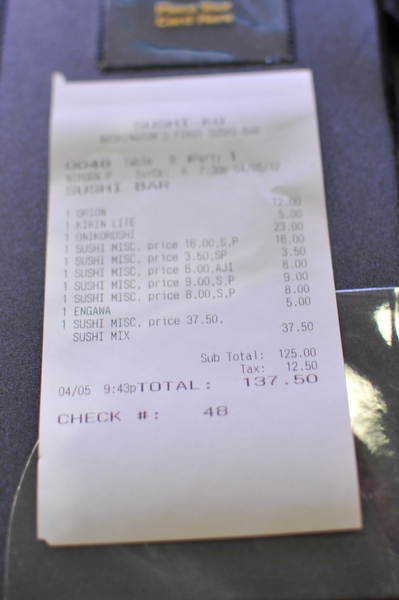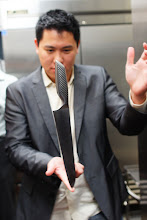2309 Wisconsin Ave NW
Washington, DC 20007
Neighborhood: Glover Park
Most debates about DC's top sushi restaurant invariably come down to three choices: Kaz Sushi Bistro, Sushi Taro, and Sushi-Ko. Having been to the first two already I felt obligated to give Ko a try this time around. I opted for the original, Glover Park location, which also has the distinction of being DC's oldest sushi restaurant having first opened November of 1976. Ko's current owner Daisuke Utagawa purchased the restaurant from the original owner in 1988 and has since then built a second more elaborate outpost in Chevy Chase Maryland.
I don't know if Utagawa once worked in the kitchen but during my visit, I was taken care of by Sushi-Ko's Executive Chef, Koji Terano. Born and raised in Osaka, Koji started his culinary training at the tender age of 18 at Gorohachi. In March of 1997, Koji responded to an advertisement that brought him to Washington DC and Sushi-Ko where he has made a name for himself over the last 15 years. Interestingly, the other 3 chefs in the restaurant spoke Cantonese to one another and when I mentioned this to Koji he confirmed that he was the only chef of Japanese descent.
Scallop
The dense sweet scallop felt a touch dry and came topped with what looked like breadcrumbs; their salty spice was a nice addition to an otherwise been an enjoyable but unremarkable scallop.

Sea Trout
This is the first time I recall having Sea Trout that wasn't Arctic Char. A very multifaceted fish, there is a bit of snap to the lush flesh and an apparent but not overwhelming fishiness.

King Mackerel
The mackerel definitely showed the results of being lightly smoked: taut firmness, concentrated salinity, and a fishy smack but much more intense than normal.

Lobster
I don't recall what the topping on this piece was but it had an earthy salinity that contrasted well with the sweetness of the dense chilled lobster.

Lobster & Uni
Another of Koji's distinctive lobster nigiri, this time he uses uni to impart the aggressive brine key to tempering the shellfish's inherent flavor.

Jack Mackerel
Though the courses up to this point were enjoyable, the quality seemed to improve from this point forward. The Aji was surprisingly rich, and laden with luxurious fish oils. The fish came with a dollop of fresh wasabi on top which conveys a sharp spike of sinus clearing heat.

Seabass Belly
This might be my first experience with seabass belly. Though the fish is saturated with oil and brine, the texture was more like engawa than toro.

Bluefin Tuna
I forgot to shoot the Zuke which came with the seabass belly. Having had the marinated tuna, the nuances of the Bluefin were much more apparent.

Yellowtail
The yellowtail lacked the marbling and patterning I've come to expect from yellowtail; the uniformly tender texture felt quite apt to the featureless surface of the fish. The topping of sesame sauce was intriguing but a bit overwhelming given the delicacy of the fish.

Wild Yellowtail Belly
In contrast to the previous piece the yellowtail belly has incredibly intricate marbling. All that fat isn't just for show as the flavor was so intoxicating that I wanted it to linger on my palate longer.

Seared Salmon Belly
The salmon was even more unctuous than the buri. The texture was akin to eating molten fat but the char and sweet onion topping keep the fish from becoming too heavy.

Engawa & Uni
This was one of my favorite pieces of the night, the engawa is ever so lightly seared which gives the flesh a slickness as well as a sinewy bite. This would have been enjoyable enough on its own but the uni and shiso make the mouthful even more intricate.

Engawa Tempura - Truffle Salt
This is my first time having engawa tempura and I can't say its an improvement. The texture loses its distinctive snappiness, becoming very similar to regular cooked halibut though the subtle fragrance of truffles does compliment the fish quite naturally.

Engawa Tempura - Ume, Shiso
Though I preferred the straightforward flavor of the truffle salt, I appreciated the sour funk of the plum and shiso.

Fatty Tuna
Quintessential toro, melty tender and fairly dripping with heady fish oil.

Salmon Egg
The first piece of sushi I ever ate as a child was Ikura and though I found it challenging at the time I've come to enjoy the cool rush of brine that issues forth when the taut globules burst.

Fatty Tuna Collar
Koji saved the big guns for the end of the meal. First up a piece of stunning Kama-toro raw with a dollop of fresh wasabi. The same rich flavor of regular fatty tuna but with a much more expressive texture.

Seared Fatty Tuna Collar
I've never been able to decide definitively whether I prefer seared or raw toro. This was definitely an argument in favor of the seared preparation. The oily fat is pared with a soft gummy texture while the daikon provides a bitter funk to clean all that heft right off the palate.

Micro Onion - Quail Egg, Bonito
A unique and thoroughly inventive creation of Koji-san's, this gunkan-style roll nicely captures the spirit of spring. The fragrant sprigs of onion play beautifully with the slick egg yolk while the bonito adds just a hint of smoky depth.

Steamed Lobster & Asparagus - Dashi Gelatin
For "dessert" Koji prepared a hemisphere of dashi jello. Encased inside the savory broth was a mix of lobster, uni, and asparagus. The resulting combination tasted heavily of shellfish with heavy vegetal and umami overtones.

The meal got off to a rocky start but improved substantially throughout the evening. I especially appreciated the contemporary twists Koji employs; the young chef is both friendly and talented and though I was eating alone he proved to be good company.
Having been to all three of DC's top sushi restaurants I'd have to say my order is Sushi Taro, Kaz Sushi Bistro, then Sushi-Ko; by traditional measures, Taro takes the cake while Kaz does the contemporary sushi thing just a bit better. By comparison, the first few pieces of fish at Sushi-Ko felt a touch dry despite having been freshly cut, though that problem faded by the fifth or sixth piece. I know it probably makes me sound like a snob, but my biggest issues were with the rice: just a bit too cold, packed too tightly, and once or twice crunchy and undercooked. Where Ko does stand out is in its accessibility. Top sushi restaurants can feel a bit forbidding or intimidating. Ko eschews such affectations, choosing to remain a casual neighborhood spot where both sushi novices and experts alike can get a good meal.

Saturday, April 14, 2012
Sushi-Ko 04/05/2012
Subscribe to:
Post Comments (Atom)

2 comments:
Engawa tempura? Engawa is my favorite sushi; I can see what you mean about frying it and destroying the texture that is so integral to a great piece of engaway.
if I were to guess from the picture, that looked like olive tapenade on top of the first lobster.
Did the chef also do the traditional wasabi between the fish and the rice, or only on top?
Post a Comment